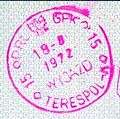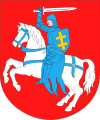Terespol
| Terespol | ||
|---|---|---|
|
Terespol local government building | ||
| ||
 Terespol | ||
| Coordinates: 52°5′N 23°34′E / 52.083°N 23.567°E | ||
| Country |
| |
| Voivodeship | Lublin | |
| County | Biała Podlaska | |
| Gmina | Terespol (urban gmina) | |
| Government | ||
| • Mayor | Jacek Danieluk | |
| Area | ||
| • Total | 10.11 km2 (3.90 sq mi) | |
| Population (2014[1]) | ||
| • Total | 5,794 | |
| • Density | 570/km2 (1,500/sq mi) | |
| Time zone | CET (UTC+1) | |
| • Summer (DST) | CEST (UTC+2) | |
| Postal code | 21-550 | |
| Car plates | LBI | |
| Website | http://www.terespol-m.netbip.pl/ | |
Terespol [tɛˈrɛspɔl] is a town in eastern Poland on the border with Belarus. It lies on the border river Bug, directly opposite the city of Brest, Belarus. It has 6,002 inhabitants (2004).
Overview
Since 1999 Terespol has been within Biała Podlaska County in Lublin Voivodeship. Between 1975 and 1998 it belonged to Biała Podlaska Voivodeship. The town is a busy border crossing between Poland and Belarus on the European route E30 which links Berlin-Warsaw-Minsk-Moscow. Another crossing into Brest is located at Kukuryki northwest of Terespol. There is also a local train between Brest, Belarus and Terespol. It comes 3 times a day. The trip takes 18 minutes and is a very comfortable way of crossing border between Belarus and Poland.
Around Terespol one can find some of the old fortifications that were once part of the Brest Fortress.
Terespol features in a novel by the Yiddish Nobel Prize-winning writer Isaac Bashevis Singer, The Family Moskat (1950), in which the young protagonist, Asa Heshel Bennet, comes to Warsaw from his hometown of Terespol Minor to study.
History
The town of Terespol is located in the spot of a village called Błotków or Błotkowo, which existed in the 16th and 17th centuries. In 1512, this area became property of a nobleman called Iwan Sapieha of Koden. Later it belonged to the Hornostaj and Dorohostajski families. In 1609, King Sigismund III of Poland built here a spacious palace with a vast garden. Due to proximity to the city of Brześć Litewski (Brest), the settlement prospered. Until the Partitions of Poland, it was part of the Grand Duchy of Lithuania. During Swedish invasion of Poland (1655 - 1660), Błotków together with the palace were ransacked and burned to the ground by Swedish soldiers.
In the second half of the 17th century, Blotkow with its ruined palace was purchased by Castellan of Vilnius Jozef Boguslaw Sluszka, who founded here a town, named Terespol after his wife, Teresa née Gosiewska. In 1697, Holy Trinity church was built here, soon afterwards, Dominican monks settled in Terespol. In 1748, Terespol became property of Grand Treasurer of Lithuania Georg Detlev von Flemming, who made great contribution to the development of the town, draining local swamps and building a number of dykes and canals. Furthermore, Flemming introduced a number of German settlers, and built a manor house in the location of the destroyed royal castle. In 1764, Terespol was ransacked by private soldiers of Polish magnate Karol Stanisław "Panie Kochanku" Radziwiłł, who waged a personal war with Flemming for his support of the Czartoryski family.
After the third partition of Poland Terespol briefly belonged to the Habsburg Empire. Later it was part of the Duchy of Warsaw, and from 1815 to 1916, it belonged to Russian-controlled Congress Poland. The town burned in several fires, but continued to prosper, due to the construction of a highway from Warsaw to Brest (1819-1823). After November Uprising, Terespol belonged to the Russian Imperial government. In 1855, due to the construction of Brest Fortress, Terespol was moved westwards, and all buildings in the old town were destroyed for military purposes. In 1867, a railroad to Warsaw was completed; in 1870, it was extended to Brest.
In 1915, all residents living within 30 kilometres (19 miles) from the fortress were forcibly resettled into Russia, and during the evacuation, the town was ransacked and burned. In the Second Polish Republic Terespol was inhabited mostly by Jews, most of whom perished in the Holocaust.
International relations
Twin towns - Sister cities
Terespol is twinned with:
Gallery
 Train in Terespol.
Train in Terespol. Old communist-era passport exit stamp from Terespol into Brest.
Old communist-era passport exit stamp from Terespol into Brest. Pomnik Niepodległości (Independence Square).
Pomnik Niepodległości (Independence Square).- Cerkiew św. Apostoła Jana Teologa w Terespolu (Eastern Orthodox church of Holy Apostle Jan Teolog in Terespol).
- Catholic church of the Holy Trinity.

References
External links
![]() Media related to Terespol at Wikimedia Commons
Media related to Terespol at Wikimedia Commons
Coordinates: 52°04′N 23°36′E / 52.067°N 23.600°E



